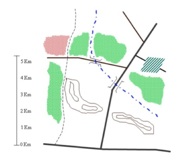Tactics 101: 030 – Planning the Defense
In this month’s article, we will focus on defensive planning. Specifically, we will discuss the mental model a commander should pursue when he must defend. For some, planning a defense can be an arduous task. With the number of moving pieces and the necessity for integration; you can quickly become overwhelmed. Once this occurs, chaos soon ensues and then defeat.
To assist us in illustrating this mental model, we will utilize a simple scenario. We will highlight the thought process of a company commander who must plan a defense focused on defeating his enemy in some complex terrain. Along the way, we will throw in some sage wisdom as it relates to the defense. We are not going to get into intricate detail in the mission analysis, since the objective is to outline the overall planning process by a commander. In the end, we hope our example will not only demonstrate the complexities of planning a defense, but provide you some ‘nuggets’ when you must plan your next defense. Let’s get started!
{default}SETTING THE STAGE
Above you see a sketch of where your impending defense will occur. You are the commander for a mechanized company team. You have at your disposable 10 Bradley Fighting Vehicles and 4 Abrams M1A1 tanks. You have excellent, responsive fire support and have an engineer platoon with outstanding digging assets to assist you in preparing the defense.
Your enemy is a motorized rifle battalion modeled from the cold war Soviet Union. They are equipped with approximately 40 BMP Infantry Fighting Vehicles and 10 T-80 Tanks. They additionally possess an impressive array of combat support assets and artillery support making them a formidable for to defeat. The unit along with the rest of the ‘horde’ is poised in assembly areas to the north preparing for the attack.
The river is not fordable by vehicles and requires bridging assets or utilizing the existing bridges (which support tank crossings). The woods are trafficable up to 400 meters off the road and the trail network. The hills severely restrict any movement to track vehicles. The hardball roads are high-speed avenues of approach. They can be utilized by both sides to quickly seize the initiative.
DISCUSSION
The defender is usually outnumbered. He is static and therefore must disperse his forces for protection from artillery, air, and ground attack. The attacker temporarily enjoys the initiative so he can mass his forces at perceived weaknesses in the defense. The attackers ability to mass, coupled with the defenders need to disperse causes the defender to face superior enemy numbers. It is not uncommon for the defender to be outnumbered by three to one or more. Companies are often asked to kill battalion-sized forces or even larger. Obviously, this can be a daunting task. It can turn into a near impossibility without proper planning and preparation.
The defender faces an “elephant” that is much larger than he is. It is an “elephant” that has great combat power potential. The only way to defeat these numbers is with measured and carefully orchestrated employment of direct and indirect fires. The defender must divide the attacker’s forces and destroy them piecemeal. Obstacles and fire control will do this when properly employed. So, what is the answer to the question “How do you eat an elephant?” That is simple, “One bite at a time!” We will tackle this scenario – One Bite at a Time.
[continued on next page]



mr sutherland(black 6) i would to talk to you about a unit that fought in desert storm. Bco 3/15 infantry. also about a driver that was said to be the best bradley driver ever produced by the US ARMY. let me know if you want to talk about tactics.
Armchair General staff cannot respond here. Please read
disclaimer just above this text box before posting.
Ozone! How are you? Are you still in? I seem to remember the
unit you’re talking about but I can’t remember a great driver. I
do remember a fairly mediocre driver who needed constant
supervision to keep his vehicle running!
Lets talk!